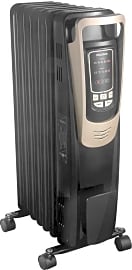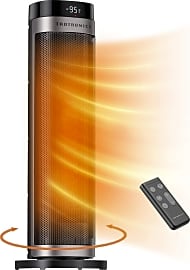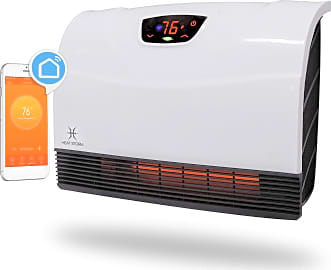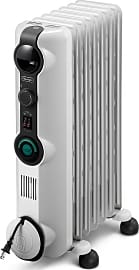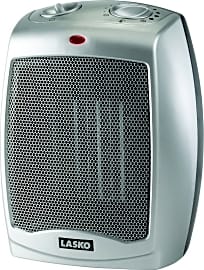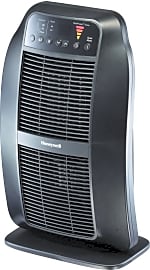The 10 Best Space Heaters

This wiki has been updated 41 times since it was first published in February of 2015. If you have a room in your house that never seems to get warm enough, or you want to turn down the central HVAC thermostat a notch to save on your energy bills without freezing to death, one of these portable heaters can be a cost-effective solution. We've included efficient electric models that are easy to fit into small spaces, as well as more powerful units designed to handle large areas. When users buy our independently chosen editorial picks, we may earn commissions to help fund the Wiki.
Editor's Notes
October 15, 2020:
I'm the type of guy who's always more partial to cold weather than hot. I've always found it much easier to warm up in the winter than to cool down when it's roasting outside in the summer or fall months. California doesn't have the typical summers that many other states do. We tend to have relatively foggy summers until around the end of August. Our "summer" starts at the beginning of September and when it gets hot here, all I can say is.....wow! We have temperature swings from 61 degrees one day to 94 the next. And our heat waves generally last for days at a time before they break. But in the winter, we also have days that drop into the low 50s and even the upper 40s. Although you'd probably see me walking outside in a t-shirt on sunny cold days like that without the need for an outdoor heater, the indoors tends to get a little chilly when trying to cut costs and conserve energy by minimizing the use of a central heating system. Therefore, having one or several of these space heaters around the house provides a cost-effective alternative for directing concentrated warmth right where we need it.
We've removed the Unique Heat Next Generation, Smart Wood Color, and Duraflame Cherry models due to availability issues.
Newly added this year is the Dr. Infrared Portable. I actually have one of these in my living room and I enjoy its slow and steady infrared heat. It warms the room quite nicely without using a lot of electricity. This one also has a 12-hour programmable timer.
While the Dyson AM09 is one of the more expensive items on our list, its bladeless design makes it a safe option for use around children and pets. It can also be used as a cooling fan during the warmer months.
Some might think that oil-filled space heaters are old school and not very effective, but the Pelonis Radiator and DeLonghi ComforTemp both provide rolling casters and a consistent source of radiant heat in medium and large rooms.
We've also included the TaoTronics TT-HE007 for its 1,500-watt power output, recessed handle for easy carrying, and top-mounted LED display for simple adjustments.
We also wanted to provide a wall-mountable option for homes where floor space may be limited, so the Heat Storm HS-1500 can definitely help in that department. Of additional convenience is its built-in WiFi connectivity, allowing you to control its settings right from your smartphone or tablet.
The ISiler Portable is great for tabletop placement and it also features a self-regulating thermostat with an auto shutoff function should its internal temperature climb above 176 degrees.
Body temperatures tend to fluctuate a lot, especially in the winter. Well, mine does at least. As strange as this might sound, I tend to sweat more quickly and easily when it's really cold outside. The reason for that could be because we're often blasting the heat inside the house to keep warm, so regular activities tend to build up a sweat faster than they do when the heat isn't running during other times of the year. Therefore, the design of the Honeywell HeatGenius makes it a convenient choice if you don't want the heat to be consistent and would rather scale it back over time. This one can be programmed to gradually step down its heat intensity every 30 minutes over a two-hour period before shutting down entirely.
September 27, 2019:
In our most recent update to this list we replaced the Vornado Vortex Personal with the Smart Wood Color, which has a similar range of function but operates more quietly and puts out more heat.
When choosing a space heater, remember to consider a model's capacity, which will determine the size of the space it will cover. On one end of the spectrum, you have heavy-duty units like the Duraflame Cherry, which is able to warm a 1,500-square-foot room. On the other end you have the Lasko Ceramic, which is recommended for nothing more expansive than a small home office.
Buyers should also pay attention to how a space heater converts electricity into heat. Convection space heaters, like the Vornado AVH10, use a fan to circulate heated air around a room and are the most energy efficient of the bunch but also tend to be noisier.
Infrared space heaters, like the Unique Heat Next Generation, are really good at quickly heating up a person they are pointed at but are not great at raising the mercury of the surrounding air. That means that there is a palpable temperature drop soon after a unit is switched off.
The DeLonghi ComforTemp is the only oil-filled radiator on the list and has a non-intrusive design, which is good because this type of space heater needs to be on in a room long enough for the heated air to radiate throughout a space.
Special Honors
Sunfire 150 Whether you work in an automotive repair center or construction site in the winter, the expensive Sunfire 150 can keep you and your crew warm for up to 19 hours with minimal effort. Constructed with a durable steel frame, its use of radiant heat technology warms objects instead of the air for long-lasting comfort. It is equipped with a 19-gallon fuel tank, sturdy rubber wheels for transport, an easy-grip handle, and a tip switch that shuts the unit off automatically if it falls over. sunfireheater.com
How Does A Space Heater Actually Heat?
Both convective and radiative space heaters require proper ventilation, and gas-powered space heaters can pose a risk of carbon monoxide poisoning if not properly monitored.
Space heaters are intended to do just what their name implies: heat a small, enclosed space for a short period of time. They are not designed to replace a long-term heating solution, nor should they be used to heat an entire home.
If you're reading this page, you might already be overwhelmed by the number of options out there for space heating. You might be torn between the choice of an electric or gas-powered device. You might not know if you need a convective or radiative heater.
Convective devices utilize either a metal or ceramic heating element through which electricity may pass, warming the element and surrounding air as a result. Convective heaters also have thermostats that can shut off when the air in the room reaches a preset temperature.
Radiative heaters use infrared technology to heat objects and people in a room. They can be more expensive than convective devices, but are often more efficient and effective.
All space heaters require certain safety precautions. Both convective and radiative space heaters require proper ventilation, and gas-powered space heaters can pose a risk of carbon monoxide poisoning if not properly monitored.
As long as you follow proper safety guidelines and do your product research, you can pick a space heater that will be perfect for you and your space.
How Do I Know What I Need?
The type of space heater you choose to buy depends on your specific needs. For instance, if you work in a small office and need a little extra heat to stay warm while you work, a radiant (or radiative) heater that uses infrared technology is probably your best bet. This type of device will heat you and the surrounding objects, while simultaneously conserving energy (and saving money).
Otherwise, it won't matter what type of heat you have - you will still be paying out the nose for your heating bill.
By contrast, if you want to increase the temperature in an entire room, a traditional convection heater might work better for this purpose, as it can heat the surrounding air with a longer range.
If you are interested in saving energy and only need to heat a small space, a space heater is a good choice for you. Try to make sure that whatever area you plan to heat is well insulated. Otherwise, it won't matter what type of heat you have - you will still be paying out the nose for your heating bill.
Consider all of the available options before making your purchase. What's right for one person might not be right for you.
From The Cave To The Living Room
In 2012, Boston University archaeologists Francesco Berna and Paul Goldberg discovered evidence of a man-made fire pit dating as far back as 1.2 million years, proving that man has been using heating systems for comfort and preparing sustenance for a long time.
Koreans and Romans used radiant heating systems in homes and other buildings dating as far back as 1,000 BCE.
Neanderthal man began using open fires on hearths inside caves for heat and cooking. Koreans and Romans used radiant heating systems in homes and other buildings dating as far back as 1,000 BCE.
Until the invention of the stove in the 17th century, indoor heating was accomplished primarily with open hearths and fireplaces, using wood or coal for their fuel sources.
The Industrial Revolution gave rise to new heating systems, including gas and steam heat, hydronic systems, registers, boilers, and radiators. By the early 19th century, a fan system was developed that helped to heat the surrounding air. This eventually necessitated the invention of thermostats in the late 19th century.
By the early 20th century, most homes were still using coal furnaces that needed to be continually filled in order to keep the home warm. Once natural gas and electricity were harnessed as viable heat sources, home heating systems became more easily accessible.
The use of natural gas and electricity not only helped to create more efficient central home heating systems, but it made small in-home space heaters possible and available to the general public.



